Dovonex Ointment
Package leaflet: Information for the user
Dovonex® Ointment
(calcipotriol)
Read all of this leaflet carefully before you start using this medicine because it contains important information for you.
• Keep this leaflet. You may need to read it again.
• If you have any further questions, ask your doctor, pharmacist or nurse.
• This medicine has been prescribed for you only. Do not pass it on to others. It may harm them, even if their signs of illness are the same as yours.
• If you get any side effects, talk to your doctor, pharmacist or nurse. This includes any possible side effects not listed in this leaflet See section 4.
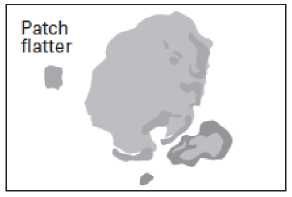
Your medicine is Dovonex® Ointment, but will be referred to as Dovonex® throughout this leaflet.
What is in this leaflet:
1. What Dovonex® is and what it is used for
2. What you need to know before you use Dovonex®
3. How to use Dovonex®
4. Possible side effects
5. How to store Dovonex®
6. Contents of the pack and other information
1. What Dovonex® is and what it is used for
Dovonex® contains the active substance calcipotriol.
Dovonex® belongs to a group of medicines called anti-psoriatics. It is a type of vitamin D.
Vitamin D controls how the cells in your skin grow.
If the cells in your skin grow too much you may get psoriasis. Psoriasis is a condition where your skin develops raised red patches and silver coloured scaly patches. The scaly patches are dead cells that would normally fall off your skin without you noticing.
Dovonex® works by reducing the amount of cells your skin makes. This means your skin symptoms will reduce too.
These diagrams explain how your skin may improve when you use this medicine.
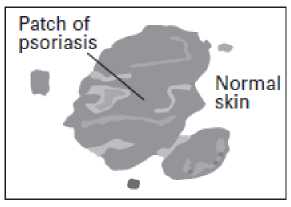
Your skin before treatment.
After about two weeks you may see a change in your skin. The scaly or flaky patches usually clear up first. They will feel smoother.
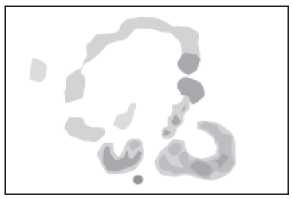
The redness of the skin will start to clear up next. It may clear up in the centre first.
Dovonex® is used to treat:
• Plaque psoriasis (psoriasis vulgaris).
2. What you need to know before you use Dovonex®
Do not use Dovonex®
• If you are allergic (hypersensitive) to calcipotriol or any of the other ingredients of this medicine (listed in section 6).
• If you have been told by a doctor that you have high or low levels of a substance called calcium in your body (calcium metabolism disorders).
• If you have severe liver problems
• If you have severe kidney problems
• Do not use on your face
• Do not use on children under 6 years old
Warnings and precautions:
Talk to your doctor, pharmacist or nurse before using
Dovonex®
• If you are already having ultraviolet (UV) light treatment.
• If you have guttate, erythrodermic, exfoliative or pustular psoriasis. Ask your doctor if you are unsure
Excess calcium in the blood (hypercalcaemia)
This medicine can cause increases in calcium levels in the body
so it is important that you do not exceed the recommended dose
(See section 4).
Raised calcium levels can produce
• Increased amounts of urine (passing water more frequently or in greater quantities than usual) and/or increased thirst
• Dry or metallic taste in the mouth
• Stomach upsets (including pain, nausea, vomiting and constipation)
• Weak muscles and/or pain in the bones
• Tiredness, fatigue and confusion
If you get any of these tell you doctor straight away.
You may get too much calcium in your blood when you use this medicine. Please read section 4 of this leaflet so that you can spot any signs this may be happening to you. Your doctor may need to change your dose.
You are not likely to get too much calcium in your blood if you use the dose prescribed for you. You can find the dose that you should use in section 3 of this leaflet. You are more likely to get too much calcium in your blood if you use more than the recommended dose each week.
Do not use Dovonex® on your face as it may irritate the skin on your face or accidentally get in your eyes. Be careful when using Dovonex® in skin folds such as armpits or under the breasts.
You may be more likely to get skin side effects in these areas.
Your doctor may tell you to limit your exposure to natural or artificial sunlight, e.g. sunbathing and sun beds, while you are using this medicine.
Children
Do not use this medicine on children under 6 years old.
Other medicines and Dovonex®
Tell your doctor or pharmacist if you are taking or have recently taken or might take any other medicines. This includes any medicines which you have bought without a prescription or herbal medicines.
Pregnancy, breast-feeding and fertility
If you are pregnant or breast-feeding, think you may be pregnant or are planning to have a baby, ask your doctor or pharmacist for advice before taking this medicine. If your doctor has agreed that you can breast-feed, do not apply Dovonex® to the breast area.
Driving and using machines
This medicine should not have any effect on your ability to drive or use machines. Check with your doctor if you develop any effects that may interfere with your ability to drive, operate machinery or take part in any other activity where they may put you or others at risk.
Important information about some of the ingredients of Dovonex®
Dovonex® contains:
• Propylene glycol. This is a skin moisturiser. It may irritate your skin.
Please ask your doctor if you are worried about any of the ingredients in this medicine.
3. How to use Dovonex®
Always use Dovonex® exactly as your doctor has told you. You should check with your doctor or pharmacist if you are not sure.
How to put on Dovonex®
This medicine is only for using on your skin or the skin of a child. Do not swallow it. Do not put it inside your body.
Never put this medicine on your face or the face of your child as it may cause irritation.
Do not mix Dovonex® with any other medicines.
Remove the cap. Check the seal is not broken before you first use the ointment. If you have a 240 gram tube, remove the foil seal on the tube. * If you have a 15 gram, 30 gram, 60 gram,
100 gram or 120 gram tube, you will need to break the seal by using the point in the back of the cap.*
Always wash your hands before using Dovonex®.
Put your medicine on the skin which has the psoriasis. You can squeeze your medicine on to your skin directly. You can squeeze it on to your finger first if you wish. Put your medicine on thickly. Then rub it in gently to cover the psoriasis.
Always wash your hands after using Dovonex®. This will stop any medicine accidentally spreading to other parts of your body. Do not worry if you accidentally get any ointment on your normal skin, but wash it off if it spreads too far.
Unless you are using the ointment to treat your hands, always wash your hands after using Dovonex®.
You should try to keep your skin well moisturised particularly after a bath or shower. If you use a moisturiser wait for it to soak in before you use your medicine.
How much Dovonex® to use
Your doctor will tell you how much Dovonex® to use, or give to your child.
For the best results you should use Dovonex® twice each day.
If you are an adult, your doctor may suggest you use the medicine once a day. If you use it twice a day, use it in the morning and in the evening. To remind you to use your medicine it may help to use it when you do another regular action, such as brushing your teeth.
Adults:
Your dose will depend on how bad your psoriasis is. Your doctor will prescribe the dose that is right for you.
Use the medicine once or twice each day. Follow the advice of your doctor.
Do not use more than 100 grams each week.
Children and adolescents:
The dose will depend on how bad the psoriasis is. Your doctor will prescribe the dose that is right for your child.
• Children over 12 years old:
Use the medicine twice each day.
Do not use more than 75 grams each week.
• Children between 6 and 12 years old:
Use the medicine twice each day.
Do not use more than 50 grams each week.
• Children under 6 years old:
Do not use on children under 6 years of age
If you use more Dovonex® than you should
Tell your doctor straight away.
You may get too much calcium in your blood. Please read sections 2 and 4 of this leaflet so you can spot any signs that this may be happening to you. Your doctor may tell you to stop taking your medicine until the amount of calcium in your blood goes back to normal.
If you forget to use Dovonex®
If you forget to use your medicine, use it as soon as you remember. Then next use your medicine at the usual time.
If you have any further questions about taking this medicine, please ask your doctor or pharmacist.
4. Possible side effects
Like all medicines, Dovonex® can cause side effects, although not everybody gets them.
Important side effects to look out for:
You must get urgent medical help if you have any of the following symptoms. You may be having an allergic reaction:
• You have difficulty breathing
• Your face including around your eyes swell
• Your skin develops a severe rash, particularly if the skin is blistering or bleeding
You should tell your doctor straight away if you spot any of the following signs which may be due to too much calcium in your blood or urine:
• You need to pass water (urine) more often
• You feel thirsty or have lost your appetite
• You have a dry mouth or a metallic taste in your mouth
• You feel weak or have pain in your muscles or bones
• You have a headache or pain in your stomach
• You feel sick or have constipation
Other possible side effects:
The possible side effects in the following section of this leaflet are usually mild.
Common side effects (may affect up to 1 in 10 people)
• Skin irritation
• Worsening of your psoriasis
• Dermatitis
• Redness
• Flaking skin
• Burning or stinging feeling
• Itchy rash and skin inflammation in the area where the medicine is used
• Itching skin
• Pain in the area where the medicine is used
Uncommon side effects (may affect up to 1 in 100 people)
• Folliculitis (infection in the hair follicle)
• Rash
• Red, itchy, scaly rash. Blisters may form. These may weep or become crusty (eczema).
• Dry skin
• Changes in skin colour where the medicine is used
Rare side effects (may affect up to 1 in 1000 people)
• Hypersensitivity (allergic reaction)
• Hypercalcaemia (too much calcium in the blood)
• Temporary increased sensitivity to sunlight
• Skin swelling or puffiness (oedema)
• Itchy raised rash (hives)
• Seborrhoeic dermatitis (such as dandruff or cradle cap)
• Hypercalciuria (too much calcium in the urine)
Reporting of side effects
If you get any side effects, talk to your doctor, pharmacist or nurse. This includes any possible side effects not listed in this leaflet. You can also report side effects directly via the Yellow Card Scheme at: www.mhra.gov.uk/yellowcard By reporting side effects, you can help provide more information on the safety of this medicine.
5. How to store Dovonex®
• Keep out of the sight and reach of children.
• Do not store above 25°C.
• Do not use after the expiry date stated on the carton after EXP. The expiry date refers to the last day of that month.
• If your medicine gets discoloured or shows any other signs of deterioration, seek the advice of your pharmacist.
• Medicines should not be disposed of via wastewater or household waste. Ask your pharmacist how to dispose of medicines you no longer use. This will help to protect the environment.
6. Contents of the pack and other information
What Dovonex® contains
• The active ingredient is calcipotriol. Each gram of ointment contains 50 micrograms of calcipotriol.
• The other ingredients are disodium edetate, disodium phosphate dihydrate, alpha-tocopherol, liquid paraffin, stearyl alcohol (2) POE, propylene glycol, purified water and white soft paraffin.
What Dovonex® looks like and contents of the pack
Dovonex® is an off white to yellowish white translucent ointment. Dovonex® is available in packs of 1 x 30g tube and 2 x 30g tube
The Manufacturer is:
LEO Laboratories Ltd., 285 Cashel Road, Dublin 12, Ireland.
LEO Pharmaceutical Products Ltd., Industriparken 55, DK-2750 Ballerup, Denmark.
Procured from within the EU & repackaged by PL holder:
Kosei Pharma UK Ltd., 956 Buckingham Avenue, Slough Trading Estate, Slough, SL1 4NL, UK
Dovonex® Ointment POM
PL 39352/0326
Dovonex® is a registered trademark of LEO Pharma A/S Leaflet date: 16/06/2016
Package leaflet: Information for the user
Calcipotriol 50 mic rograms/g Ointment
Read all of this leaflet carefully before you start using this medicine because it contains important information for you.
• Keep this leaflet. You may need to read it again.
• If you have any further questions, ask your doctor, pharmacist or nurse.
• This medicine has been prescribed for you only. Do not pass it on to others. It may harm them, even if their signs of illness are the same as yours.
• If you get any side effects, talk to your doctor, pharmacist or nurse. This includes any possible side effects not listed in this leaflet See section 4.
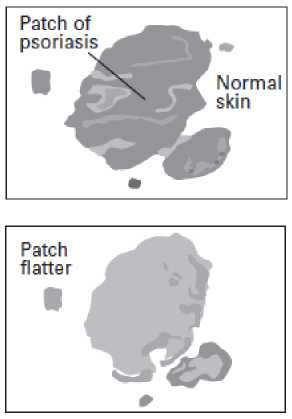
Your skin before treatment.
Your medicine is Calcipotriol 50 micrograms/g Ointment, but will be referred to as Calcipotriol Ointment throughout this leaflet.
What is in this leaflet:
1. What Calcipotriol Ointment is and what it is used for
2. What you need to know before you use Calcipotriol Ointment
3. How to use Calcipotriol Ointment
4. Possible side effects
5. How to store Calcipotriol Ointment
6. Contents of the pack and other information
1. What Calcipotriol Ointment is and what it is used for
Calcipotriol Ointment contains the active substance calcipotriol. Calcipotriol Ointment belongs to a group of medicines called anti-psoriatics.
It is a type of vitamin D.
Vitamin D controls how the cells in your skin grow.
If the cells in your skin grow too much you may get psoriasis. Psoriasis is a condition where your skin develops raised red patches and silver coloured scaly patches. The scaly patches are dead cells that would normally fall off your skin without you noticing.
Calcipotriol Ointment works by reducing the amount of cells your skin makes. This means your skin symptoms will reduce too.
These diagrams explain how your skin may improve when you use this medicine.
After about two weeks you may see a change in your skin. The scaly or flaky patches usually clear up first. They will feel smoother.
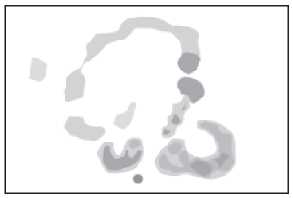
The redness of the skin will start to clear up next. It may clear up in the centre first.
Calcipotriol Ointment is used to treat:
• Plaque psoriasis (psoriasis vulgaris).
2. What you need to know before you use Calcipotriol Ointment Do not use Calcipotriol Ointment
• If you are allergic (hypersensitive) to calcipotriol or any of the other ingredients of this medicine (listed in section 6).
• If you have been told by a doctor that you have high or low levels of a substance called calcium in your body (calcium metabolism disorders).
• If you have severe liver problems
• If you have severe kidney problems
• Do not use on your face
• Do not use on children under 6 years old
Warnings and precautions:
Talk to your doctor, pharmacist or nurse before using Calcipotriol Ointment
• If you are already having ultraviolet (UV) light treatment.
• If you have guttate, erythrodermic, exfoliative or pustular psoriasis. Ask your doctor if you are unsure
Excess calcium in the blood (hypercalcaemia)
This medicine can cause increases in calcium levels in the body so it is important that you do not exceed the recommended dose (See section 4).
Raised calcium levels can produce
• Increased amounts of urine (passing water more frequently or in greater quantities than usual) and/or increased thirst
• Dry or metallic taste in the mouth
• Stomach upsets (including pain, nausea, vomiting and constipation)
• Weak muscles and/or pain in the bones
• Tiredness, fatigue and confusion
If you get any of these tell you doctor straight away.
You may get too much calcium in your blood when you use this medicine. Please read section 4 of this leaflet so that you can spot any signs this may be happening to you. Your doctor may need to change your dose.
You are not likely to get too much calcium in your blood if you use the dose prescribed for you. You can find the dose that you should use in section 3 of this leaflet. You are more likely to get too much calcium in your blood if you use more than the recommended dose each week.
Do not use Calcipotriol Ointment on your face as it may irritate the skin on your face or accidentally get in your eyes. Be careful when using Calcipotriol Ointment in skin folds such as armpits or under the breasts. You may be more likely to get skin side effects in these areas.
Your doctor may tell you to limit your exposure to natural or artificial sunlight, e.g. sunbathing and sun beds, while you are using this medicine.
Children
Do not use this medicine on children under 6 years old.
Other medicines and Calcipotriol Ointment
Tell your doctor or pharmacist if you are taking or have recently taken or might take any other medicines. This includes any medicines which you have bought without a prescription or herbal medicines.
Pregnancy, breast-feeding and fertility
If you are pregnant or breast-feeding, think you may be pregnant or are planning to have a baby, ask your doctor or pharmacist for advice before taking this medicine. If your doctor has agreed that you can breast-feed, do not apply Calcipotriol Ointment to the breast area.
Driving and using machines
This medicine should not have any effect on your ability to drive or use machines. Check with your doctor if you develop any effects that may interfere with your ability to drive, operate machinery or take part in any other activity where they may put you or others at risk.
Important information about some of the ingredients of Calcipotriol Ointment
Calcipotriol Ointment contains:
• Propylene glycol. This is a skin moisturiser. It may irritate your skin.
Please ask your doctor if you are worried about any of the ingredients in this medicine.
3. How to use Calcipotriol Ointment
Always use Calcipotriol Ointment exactly as your doctor has told you. You should check with your doctor or pharmacist if you are not sure.
How to put on Calcipotriol Ointment
This medicine is only for using on your skin or the skin of a child. Do not swallow it. Do not put it inside your body.
Never put this medicine on your face or the face of your child as it may cause irritation.
Do not mix Calcipotriol Ointment with any other medicines.
Remove the cap. Check the seal is not broken before you first use the ointment. If you have a 240 gram tube, remove the foil seal on the tube. * If you have a 15 gram, 30 gram, 60 gram,
100 gram or 120 gram tube, you will need to break the seal by using the point in the back of the cap.*
Always wash your hands before using Calcipotriol Ointment.
Put your medicine on the skin which has the psoriasis. You can squeeze your medicine on to your skin directly. You can squeeze it on to your finger first if you wish. Put your medicine on thickly. Then rub it in gently to cover the psoriasis.
Always wash your hands after using Calcipotriol Ointment. This will stop any medicine accidentally spreading to other parts of your body. Do not worry if you accidentally get any ointment on your normal skin, but wash it off if it spreads too far.
Unless you are using the ointment to treat your hands, always wash your hands after using Calcipotriol Ointment.
You should try to keep your skin well moisturised particularly after a bath or shower. If you use a moisturiser wait for it to soak in before you use your medicine.
How much Calcipotriol Ointment to use
Your doctor will tell you how much Calcipotriol Ointment to use, or give to your child.
For the best results you should use Calcipotriol Ointment twice each day.
If you are an adult, your doctor may suggest you use the medicine once a day. If you use it twice a day, use it in the morning and in the evening. To remind you to use your medicine it may help to use it when you do another regular action, such as brushing your teeth.
Adults:
Your dose will depend on how bad your psoriasis is. Your doctor will prescribe the dose that is right for you.
Use the medicine once or twice each day. Follow the advice of your doctor.
Do not use more than 100 grams each week.
Children and adolescents:
The dose will depend on how bad the psoriasis is. Your doctor will prescribe the dose that is right for your child.
• Children over 12 years old:
Use the medicine twice each day.
Do not use more than 75 grams each week.
• Children between 6 and 12 years old:
Use the medicine twice each day.
Do not use more than 50 grams each week.
• Children under 6 years old:
Do not use on children under 6 years of age
If you use more Calcipotriol Ointment than you should
Tell your doctor straight away.
You may get too much calcium in your blood. Please read sections 2 and 4 of this leaflet so you can spot any signs that this may be happening to you. Your doctor may tell you to stop taking your medicine until the amount of calcium in your blood goes back to normal.
If you forget to use Calcipotriol Ointment
If you forget to use your medicine, use it as soon as you remember. Then next use your medicine at the usual time.
If you have any further questions about taking this medicine, please ask your doctor or pharmacist.
4. Possible side effects
Like all medicines, Calcipotriol Ointment can cause side effects, although not everybody gets them.
Important side effects to look out for:
You must get urgent medical help if you have any of the following symptoms. You may be having an allergic reaction:
• You have difficulty breathing
• Your face including around your eyes swell
• Your skin develops a severe rash, particularly if the skin is blistering or bleeding
You should tell your doctor straight away if you spot any of the following signs which may be due to too much calcium in your blood or urine:
• You need to pass water (urine) more often
• You feel thirsty or have lost your appetite
• You have a dry mouth or a metallic taste in your mouth
• You feel weak or have pain in your muscles or bones
• You have a headache or pain in your stomach
• You feel sick or have constipation
Other possible side effects:
The possible side effects in the following section of this leaflet are usually mild.
Common side effects (may affect up to 1 in 10 people)
• Skin irritation
• Worsening of your psoriasis
• Dermatitis
• Redness
• Flaking skin
• Burning or stinging feeling
• Itchy rash and skin inflammation in the area where the medicine is used
• Itching skin
• Pain in the area where the medicine is used
Uncommon side effects (may affect up to 1 in 100 people)
• Folliculitis (infection in the hair follicle)
• Rash
• Red, itchy, scaly rash. Blisters may form. These may weep or become crusty (eczema).
• Dry skin
• Changes in skin colour where the medicine is used
Rare side effects (may affect up to 1 in 1000 people)
• Hypersensitivity (allergic reaction)
• Hypercalcaemia (too much calcium in the blood)
• Temporary increased sensitivity to sunlight
• Skin swelling or puffiness (oedema)
• Itchy raised rash (hives)
• Seborrhoeic dermatitis (such as dandruff or cradle cap)
• Hypercalciuria (too much calcium in the urine)
Reporting of side effects
If you get any side effects, talk to your doctor, pharmacist or nurse. This includes any possible side effects not listed in this leaflet. You can also report side effects directly via the Yellow Card Scheme at: www.mhra.gov.uk/yellowcard By reporting side effects, you can help provide more information on the safety of this medicine.
5. How to store Calcipotriol Ointment
• Keep out of the sight and reach of children.
• Do not store above 25°C.
• Do not use after the expiry date stated on the carton after EXP. The expiry date refers to the last day of that month.
• If your medicine gets discoloured or shows any other signs of deterioration, seek the advice of your pharmacist.
• Medicines should not be disposed of via wastewater or household waste. Ask your pharmacist how to dispose of medicines you no longer use. This will help to protect the environment.
6. Contents of the pack and other information
What Calcipotriol Ointment contains
• The active ingredient is calcipotriol. Each gram of ointment contains 50 micrograms of calcipotriol.
• The other ingredients are disodium edetate, disodium phosphate dihydrate, alpha-tocopherol, liquid paraffin, stearyl alcohol (2) POE, propylene glycol, purified water and white soft paraffin.
What Calcipotriol Ointment looks like and contents of the pack
Calcipotriol Ointment is an off white to yellowish white translucent ointment.
Calcipotriol Ointment is available in packs of 1 x 30g tube and 2 x 30g tube.
The Manufacturer is:
LEO Laboratories Ltd., 285 Cashel Road, Dublin 12, Ireland.
LEO Pharmaceutical Products Ltd., Industriparken 55, DK-2750 Ballerup, Denmark.
Procured from within the EU & repackaged by PL holder:
Kosei Pharma UK Ltd., 956 Buckingham Avenue, Slough Trading Estate, Slough, SL1 4NL, UK
Calcipotriol 50 micrograms/g Ointment PL 39352/0326
Leaflet date: 16/06/2016 POM